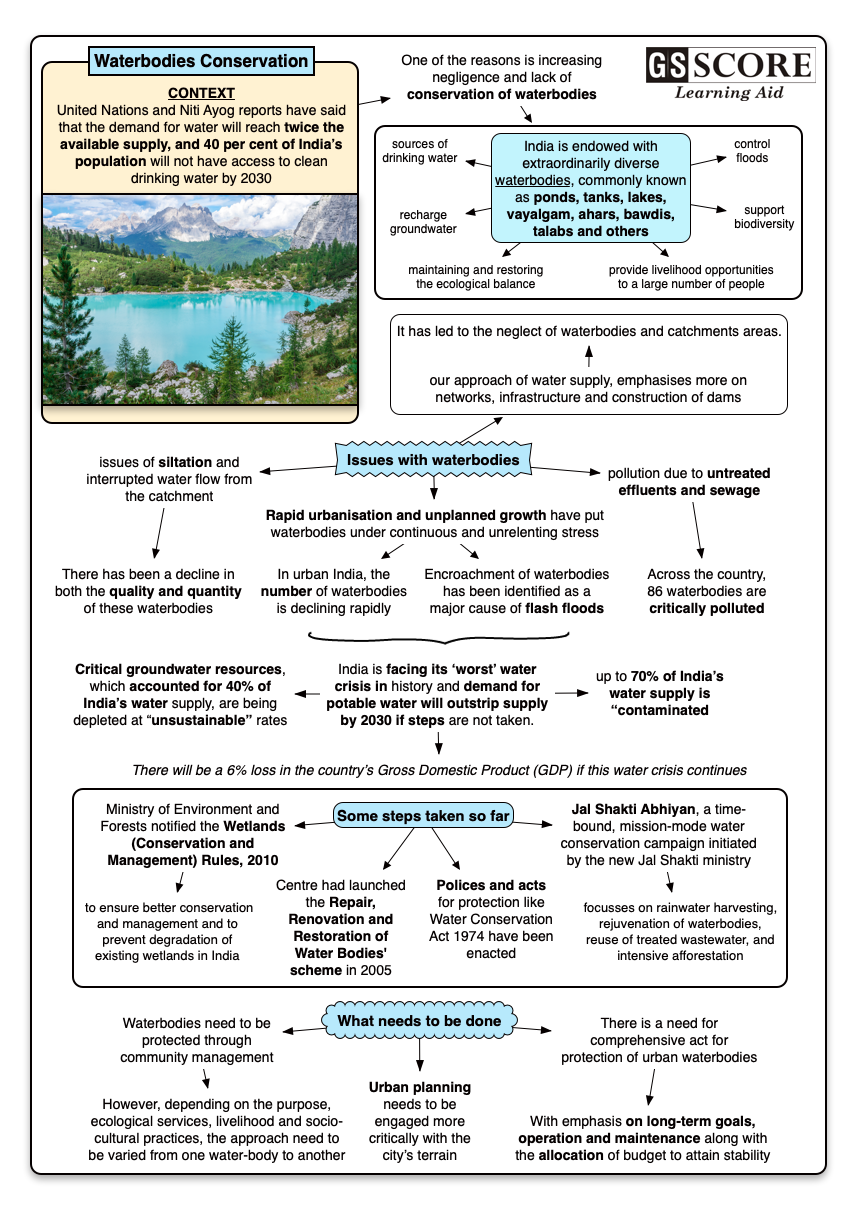

United Nations and Niti Ayog reports has said that the demand for water will reach twice the available supply, and 40 per cent of India’s population will not have access to clean drinking water by 2030.
Issue
Context
United Nations and Niti Ayog reports has said that the demand for water will reach twice the available supply, and 40 per cent of India’s population will not have access to clean drinking water by 2030.
Background
- India is endowed with extraordinarily diverse and distinctive traditional waterbodies found in different parts of the country, commonly known as ponds, tanks, lakes, vayalgam, ahars, bawdis, talabs and others.
- They play an important role in maintaining and restoring the ecological balance. They act as sources of drinking water, recharge groundwater, control floods, support biodiversity, and provide livelihood opportunities to a large number of people.
- Currently, a major water crisis is being faced by India, where 100 million people are on the frontlines of a nationwide water crisis and many major cities facing an acute water shortage.
- The situation will worsen as United Nations and Niti Ayog reports say that the demand for water will reach twice the available supply, and 40 per cent of India’s population will not have access to clean drinking water by 2030.
Issues
- One of the reasons is increasing negligence and lack of conservation of waterbodies.
- Since independence, the government has taken control over the waterbodies and water supply.
- With a colonial mindset, authorities move further and further away in the quest of water supply, emphasising more on networks, infrastructure and construction of dams.
- It has led to the neglect of waterbodies and catchments areas.
- Thus, we have started valuing land more than water.
- Rapid urbanisation and unplanned growth have put waterbodies under continuous and unrelenting stress.
- Waterbodies are being polluted by untreated effluents and sewage that are continuously being dumped into them
- Lack of data and action plans, encroachments, interrupted water flow from the catchment, siltation, and violations of laws, solid waste deposit and polluted water and involvement of too many agencies.
Impacts
- Encroachment of waterbodies has been identified as a major cause of flash floods in Mumbai (2005), Uttarakhand (2013), Jammu and Kashmir (2014) and Chennai (2015).
- Across the country, 86 waterbodies are critically polluted, having a chemical oxygen demand or COD concentration of more than 250 mg/l.
- In urban India, the number of waterbodies is declining rapidly. For example, in the 1960s Bangalore had 262 lakes. Now, only 10 hold water.
- Similarly, in 2001, 137 lakes were listed in Ahmedabad. However, by 2012, 65 were already destroyed and built upon.
- The decline in both the quality and quantity of these waterbodies is to the extent that their potential to render various economic and environmental services has reduced drastically.
- India is facing its ‘worst’ water crisis in history and that demand for potable water will outstrip supply by 2030 if steps are not taken.
- Nearly 600 million Indians faced high to extreme water stress and about 2,00,000 people died every year due to inadequate access to safe water.
- There will be a 6% loss in the country’s Gross Domestic Product (GDP) if this water crisis continues.
- Critical groundwater resources, which accounted for 40% of India’s water supply, are being depleted at “unsustainable” rates and up to 70% of India’s water supply is “contaminated.
Actions Taken
- Sufficient polices and acts for protection like Water Conservation Act 1974 have been enacted for protection and restoration of waterbodies
- Realising the seriousness of the problem confronting waterbodies, the Centre had launched the Repair, Renovation and Restoration of Water Bodies' scheme in 2005 with the objectives of comprehensive improvement and restoration of traditional waterbodies.
- Ministry of Environment and Forests notified the Wetlands (Conservation and Management) Rules, 2010 to ensure better conservation and management and to prevent degradation of existing wetlands in
- It included increasing tank storage capacity, ground water recharge, increased availability of drinking water, improvement of catchment areas of tank commands and others.
- Jal Shakti Abhiyan, a time-bound, mission-mode water conservation campaign initiated by the new Jal Shakti ministry is a welcome step focussing on rainwater harvesting, rejuvenation of waterbodies, reuse of treated wastewater, and intensive afforestation.
- Many cities are working towards conservation of waterbodies like the steps initiated in the capital city of Delhi for In turning Delhi into a city of lakes, rejuvenation of 201 waterbodies has been finalised.
Way Forward
- Urban planning needs to be engaged more critically with the city’s terrain, along with propagation of knowledge about the local history of lakes, meaningful community engagement and ownership of waterbodies.
- Waterbodies being an important source of water, their protection through community management and the need of a comprehensive act for the protection of urban waterbodies.
- No one size fits all approach - Depending on the purpose, ecological services, livelihood and socio-cultural practices, the approach need to be varied from one water-body to another.
- Emphasis on long-term goals, operation and maintenance should be included along with the allocation of budget to attain stability.
- Invest in governance, capacitating our institutions, strong regulations and their enforcements.
Let us not destroy our waterbodies in the name of development. Rather, we should value their importance.
Learning Aid
Practice Question:
Explain how conserving waterbodies can help tackle India’s worst water crisis.




